I spent last weekend in San Diego, where I saw some Schlage L9000 series locks with indicators on the restrooms at a state park/beach. As I was checking out the restroom traffic (waiting for my opportunity to take photos of the locks), I was reminded of a recent question that I received regarding lock indicators.
Locks with indicators have grown in popularity in recent years. In a restroom application, it is very easy to see from the color-coded “occupied/vacant” indicators which restrooms are available for use. The restrooms at the beach also had indicators on the inside. This is really helpful when you’re in the restroom wondering if the door is locked to prevent someone else from entering.


Here is the indicator on the outside of the restroom:
And on the inside:
Click here to see a video of how this lock allows egress.
Some educational facilities are using indicator locks on classrooms; this allows the staff and students to see clearly whether the doors are locked to prevent an unauthorized person from entering. Without an indicator, it can be difficult to know for sure whether the lock is locked on the outside during a lockdown. Indicator locks are recommended for classroom doors in the guidelines published by the Partner Alliance for Safer Schools (PASS) and this recommendation is also included in the draft of the school security standard from ASIS International that is currently in development.
I was really surprised when someone recently asked me whether a locked indicator would be considered “special knowledge” for a building occupant who is attempting to exit. They wondered if someone seeing the word “locked” might believe that they would be unable to exit by turning the lever handle or pushing the touchpad of the panic hardware. My answer – no special knowledge is needed to operate hardware with an indicator.
The model codes require egress doors to be readily openable from the egress side without the use of a key or special knowledge or effort. Hardware must also operate without tight grasping, pinching, or twisting of the wrist, and within the operable force limits of the codes and standards. The mounting height of the releasing hardware must be between 34 inches and 48 inches above the floor, or as further limited by state or local requirements.
To clarify the intent of the International Building Code (IBC), the IBC Commentary states:
Egress doors are permitted to be locked to prevent entry, but must be capable of being unlocked and readily openable from the side from which egress is to be made. The outside of a door (the access side of the door) can be locked and unlocked with a key or electronic credential such as a card, fob, or code as long as the inside—the side from which egress is to be made—can be unlocked without the use of tools, keys or special knowledge or effort. For example, an unlocking operation that is integral with an unlatching operation is acceptable.
Although indicators are not specifically mentioned in the code or Commentary, the Commentary includes additional information about special knowledge. Locks with indicators are not similar to the examples in the Commentary:
Examples of special knowledge would be a combination lock or an unlocking device or deadbolt in an
unknown, unexpected or hidden location. Special effort would dictate the need for unusual and unexpected physical ability to unlock or make the door fully available for egress, or the need for two actions to be conducted simultaneously to release the latch.
The indicator locks that prompted this question were installed on college classroom doors during a renovation project. Locks with indicators had been installed in other campus buildings previously. When a student or staff member enters the classroom, the indicator on the inside of the door will say “unlocked” until the key or thumbturn is used (depending on the lock function) to lock the outside lever from within the classroom. After locking the door, the indicator will say “locked.” The locks allow free egress at all times by turning the lever and are the type of locks described in the Commentary as acceptable – an unlocking operation that is integral with an unlatching operation.
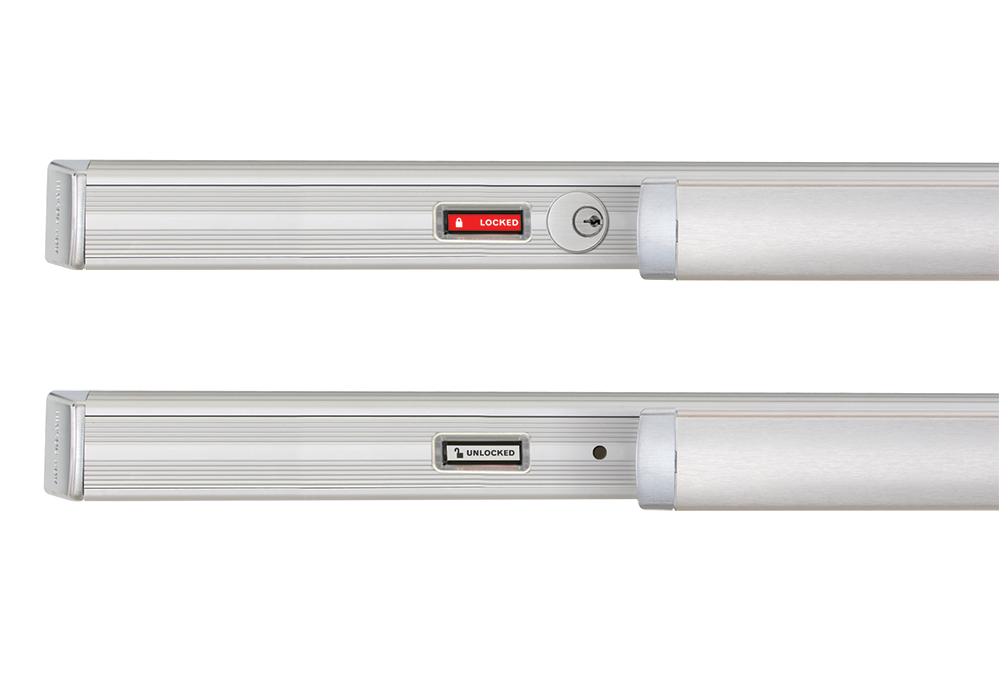 This project also includes panic hardware with indicators. When a door is equipped with panic hardware, a locked indicator can be extremely helpful during a lockdown or for general security. Whether the hardware is dogged or undogged, or if the lever handle on the outside is locked or unlocked, an indicator on the egress side can be used to show the locked status. Doors with panic hardware or locksets incorporating indicators allow free egress at all times via the panic hardware touchpad – the indicator only shows the status with regard to access, not egress.
This project also includes panic hardware with indicators. When a door is equipped with panic hardware, a locked indicator can be extremely helpful during a lockdown or for general security. Whether the hardware is dogged or undogged, or if the lever handle on the outside is locked or unlocked, an indicator on the egress side can be used to show the locked status. Doors with panic hardware or locksets incorporating indicators allow free egress at all times via the panic hardware touchpad – the indicator only shows the status with regard to access, not egress.
I requested a staff opinion from the International Code Council (ICC) about this question and they agreed that displaying the word “locked” does not (in their opinion) constitute special knowledge. Locksets and panic hardware with indicators allow free egress and meet all of the requirements stated in the codes. These products operate exactly the same as hardware without an indicator, and provide the added reassurance that the outside lever is locked. They are becoming more common in many types of facilities. For these reasons I say:
Locks with indicators do not require special knowledge to operate; their operation is common knowledge.*
What do you think?
~~~
Note: As some jurisdictions adopt NFPA 101, Life Safety Code, I have included the text from that code and the handbook regarding special knowledge below. I believe that the intent of the Life Safety Code is the same as the I-Codes.
7.2.1.5.10* A latch or other fastening device on a door leaf shall be provided with a releasing device that has an obvious method of operation and that is readily operated under all lighting conditions.
A.7.2.1.5.10 Examples of devices that might be arranged to release latches include knobs, levers, and bars. This requirement is permitted to be satisfied by the use of conventional types of hardware, whereby the door is released by turning a lever, knob, or handle or by pushing against a bar, but not by unfamiliar methods of operation, such as a blow to break glass. It is also within the intent of this requirement that switches integral to traditional doorknobs, lever handles, or bars, and that interrupt the power supply to an electromagnetic lock, be permitted, provided that they are affixed to the door leaf. The operating devices should be capable of being operated with one hand and should not require tight grasping, tight pinching, or twisting of the wrist to operate.
NFPA 101 Handbook: Paragraph 7.2.1.5.10 requires that, where a latch or other similar device is provided, the method of operation of its releasing device must be obvious, even in the dark. The intention of this requirement is that the method of release be one that is familiar to the average person. Generally, a two-step release, such as a knob and an independent slide bolt, is not permitted. In most occupancies, it is important that a single action unlatch the door assembly.
*I am not an AHJ, just a person with an (educated) opinion. Consult with your local AHJ for their interpretation.
You need to login or register to bookmark/favorite this content.



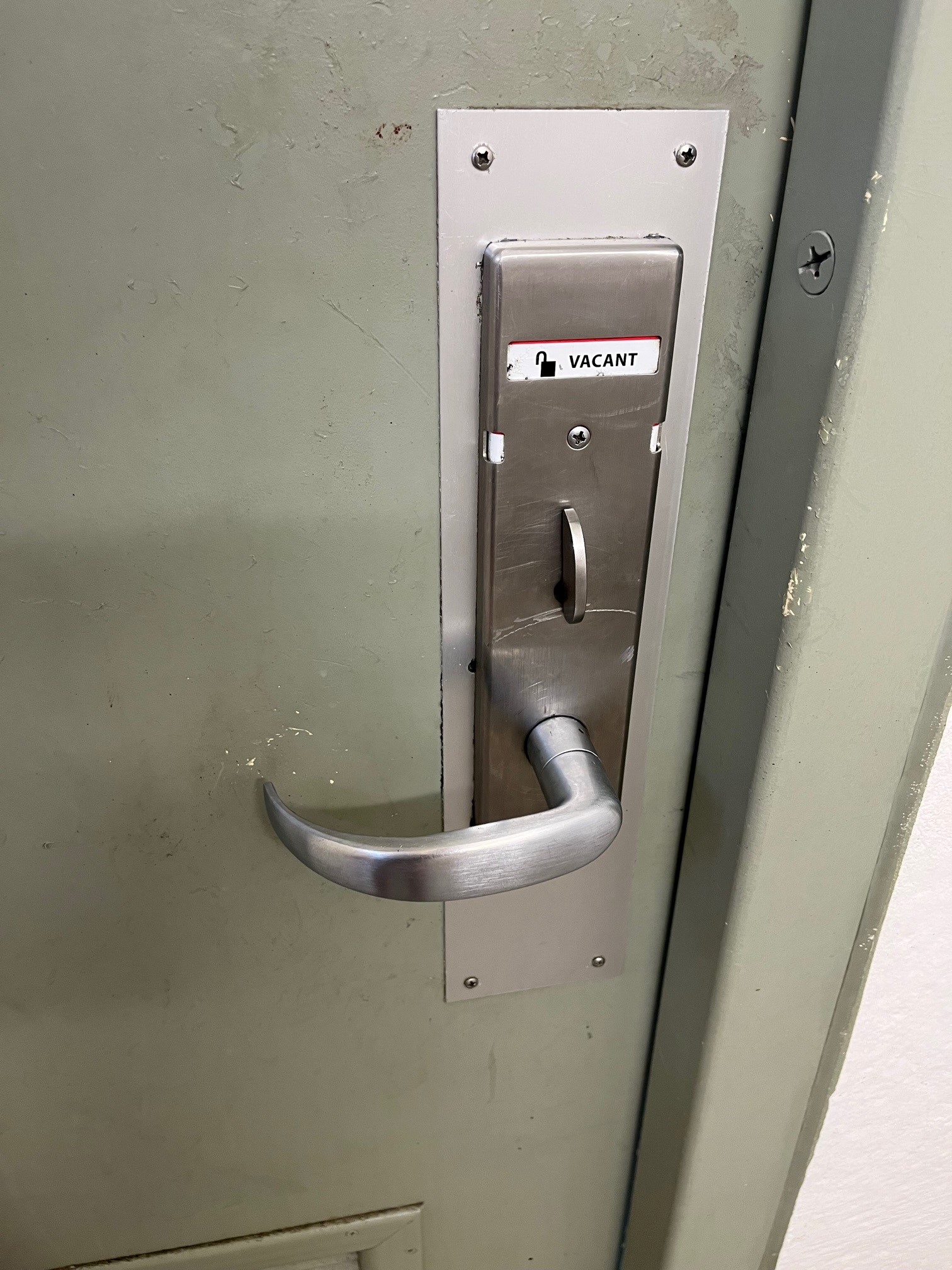

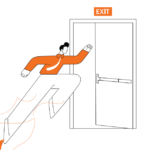
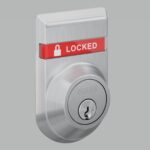
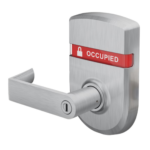




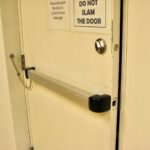
Sign sign everywhere a sign.
As to would it give a person pause, I think I would include it with other signs posted, such as Fire Exit only, Emergency Exit Only,,, etc.
Yes I do think in some instances they may deter a person from using a door.
One problem I see, is the indicator either does not work or has been scratched up, so you cannot read it.
So my question, on doors requiring the indicator,,, is there a code to maintain them????
Loved the Torrey Pine pictures, part of my old stomping grounds, and beautiful area.
Hi Charles –
What if the indicator was just red or white without the words? Would you feel different about that?
– Lori
As long as they work and are maintained
I work for a large state university that had an active shooter event in April; the university pushed the “Big Button” that engaged all electrified locks on campus. Apparently, some people complained that the classroom doors “didn’t lock” because they tried them from the inside…and lo and behold, they were unlocked.
At first, you’re tempted to think of the Hollywood trope that a typical electrified lock locks both sides (think of how many people actually believe that fire sprinklers work like in Hollywood). But in a panic situation like an active shooter, don’t expect straightforward thinking.
Are electrified locks or panics available with indicators? In an emergency, it would be quite helpful to have an indicator on the inside for the benefit of people in the room.
Hi Matt –
Some electrified locks have indicators in the form of LEDs, and there is panic hardware with indicators. There are some images of the panics in this post: https://idighardware.com/2024/06/indicators-when-where-and-why/.
– Lori
i do not like the idea of an indicator on the classroom side of the door, indicating that it is “locked”.
i can see that it could sow doubt that the door could be used for egress.
Hi Paul –
As we see more and more of these locks, they will be familiar to building occupants. I just saw some yesterday on a children’s hospital waiting room. Would you feel different if the locks just had a red/white indicator without the words?
– Lori
Great Post Lori!
Lock indicators represent a natural, code-compliant evolution in the ongoing effort to balance life safety considerations. Historically, life safety protocols focused primarily on fire threats. However, today’s threat landscape requires a broader perspective—one that includes other risks to building occupants, such as active assailant scenarios. As a result, fire safety professionals have had to shift their approach, acknowledging that in some emergencies, remaining in a secured space may be safer than evacuating.
The International Code Council (ICC) have also evolved in response, recognizing the importance of clarity and simplicity in door hardware. Both codes discourage the use of additional, non-compliant devices intended to secure doors, instead favoring solutions—like lock indicators—that enhance security without compromising egress.
Lock indicators function much like emergency exit signage: they inform occupants, rather than control their actions. In a true emergency, a person is unlikely to stop and consider whether a door labeled “Emergency Exit Only – Alarm Will Sound” is permissible to use. They will instinctively push the crash bar or turn the handle to escape. Conversely, in non-emergency situations, the same signage may prompt someone to find an alternate route. The presence of a “locked” indicator on the inside of a door serves a similar function—providing information, not creating a barrier.
Concerns that such indicators might prevent someone from attempting to exit in an emergency are, in my view, unfounded. History provides too many tragic examples—such as the 1911 Triangle Shirtwaist Factory fire—where lives were lost because individuals were trapped behind locked doors. These events underscore the absolute necessity that all egress doors be operable from the inside without special knowledge or effort, regardless of whether a lock indicator is present.
In this context, I believe both the ICC and the Partner Alliance for Safer Schools (PASS) are correct in supporting the use of lock indicators. Far from posing a risk, these devices enhance occupant awareness and contribute to more effective life safety strategies. Lock indicators can save lives—not cost them.
We have been fortunate to have had the opportunity to retrofit 3 different Community Colleges with Locked / unLocked indicators, and this question has come up. The confusion is because, the word LOCKED means one thing on the outside of the door, and means another thing on the inside.
The answer might be to eliminate the printed word, and just show the color red. Less chance for confusion. An example of how tis works: When retro-fitting some other brands of exit devices that did not have open/closed indicators yet, we used CO400’s that show a red light when the door is in locked on the outside mode. (Thanks to Matt Linch for that solution).
A teacher can see from across the room the red color, and know the door is locked from the outside.
Or is there another word that could be used instead of “locked”?
I echo Scott Lord’s response. Additionally, I would add that in an active assailant situation, particularly if it is an active shooter, protocol is to lock the door and get away from it. It has been documented that bullets can and do penetrate doors, steel and solid core wood. If the lock can be identified as being locked, no one need go to the door to check if it is locked. They can proceed to shelter in a secure area of the room without delay. Some lock functions might actually require opening the door to check the condition of the lock.
The emergency management spectrum spans “Prevention, Protection, Mitigation, Response and Recovery”. Indicators play a role in every aspect of the spectrum and should be required on all classroom doors.
Great post and continued discussion Lori,
We know all too well that in a classroom lockdown, for any reason, seconds matter. One of the biggest risks is uncertainty; teachers, substitutes, staff, and students may not know if the classroom door is secured against unauthorized entry. Without a visual indicator, they must test or guess the lock’s status from outside the classroom, wasting precious time and potentially exposing themselves and others to danger.
Interior visual indicators solve this problem. They provide immediate, unmistakable confirmation, visible from across the room, that the outside lever is locked. This reassurance eliminates doubt in high-stress situations, shortens the time it takes to confirm a room is secure, and allows staff to focus on protecting students/occupants rather than checking the lock. Students and staff spend significant time in these rooms and will quickly adapt to this visual cue. Consistency across classrooms, campuses, and districts is key.
These indicator locks fully comply with code requirements for free egress, turning the lever or pushing the panic or fire exit hardware always allows exit without keys, tools, or special knowledge. “Green vs. Red” and “Locked vs. Unlocked” are basic, universally understood concepts, familiar even to young children. The indicator refers only to the access availability from the outside of the room and does not impede the instinct for exiting from inside.
Indicator locks combine the life-safety benefits of code-compliant hardware with the real-world benefit of instant, obvious feedback. They are a simple, low-cost, high-impact upgrade, and I always recommend them as one of the first steps in any school security plan.
I think the simplest solution to the problem would be to change the wording on the interior indicator from “LOCKED”/”UNLOCKED” to “SECURED”/”OPEN” or some other equivalent turn of phrase that conveys that the door is secure without necessarily saying it’s locked. (Given that lockdown might be implemented by cylinder undogging of a dogged panic with a dummy pull…)
As I read through this post and the comments, I also thought that “Secure” was a better term to use than “Locked” Might be because I was an English teacher before becoming an architect, or maybe I’m too literal (Don’t ask my wife.).
Lori,
I agree that the indicator does not represent a barrier to egress by adding a special knowledge requirement. We are merely adding information to the equation. This information is providing peace of mind to the occupants of the class room.
Much like your bathroom example gave you peace of mind that you had indeed locked the bathroom door behind you. Adding an inside indicators gives a teacher peace of mind that they are secure behind a locked door.
-Mark
Thanks for this post, Lori. I don’t mind someone challenging the use of indicator locks or any other product, for that matter. We all benefit from productive dialogue and accountability in collaborative settings. In this case, I feel certain that indicator locks do not require “special knowledge” to operate. Your citations and line of reasoning are sound. Indicator locks permit free egress at all times.
On a personal note, I have continuously witnessed people (present company included) benefit from the presence of indicator locks at airport restrooms.
Thanks for all you do, Lori! As a member of the PASS Technical Committee and the NFPA 3000 Technical Committee, having sat through extensive discussions with other school security experts, I believe that indicators serve a critical purpose. The PASS Guidelines and the new ASIS School Security Standard both recommend their use, following a long debate among multidisciplinary experts about the need for clear visual assurance that a door is secure.
When indicators are not provided, schools often resort to makeshift devices to create that sense of security. Unfortunately, these are not code-compliant, can delay egress, and may provide a dangerous false sense of protection.
Code-compliant locks and exit hardware with indicators solve this problem. They give clear, immediate visual confirmation while maintaining free and immediate egress. Their use is intuitive and requires no special knowledge.
Removing this option would eliminate a proven, standards-backed safety measure that protects students and staff, and would represent a significant step backward in terms of safety and security.
Thanks for this post, Lori. I have to admit, I am really surprised by the need for it and some of the feedback. Indicator locks play a vital role in both daily operations and emergency scenarios, particularly in educational environments where it is essential to know the status of the lock. Being able to visually confirm whether a door is locked from the inside provides immediate awareness, which is especially critical during a lockdown when seconds matter.
Without an indicator, occupants may be unsure whether the door is actually secured against unauthorized entry. That uncertainty can lead to hesitation, delays in securing spaces, or even the use of improvised barricade devices. Barricade devices are not compliant with life safety codes and introduce serious risks, including obstructed egress, delayed emergency response, and violations of ADA accessibility requirements, and, most importantly of all, barricade devices can create bigger vulnerabilities and problems. Indicators do not change how the lock functions – egress is maintained, no special knowledge is needed, and they are accessible to all.
PASS guidelines explicitly recommend indicator locks for classroom doors, and the upcoming school security standard from ASIS International reinforces this recommendation. These endorsements reflect a growing consensus that security solutions must support both access control and safe egress. Indicator locks do exactly that. They allow occupants to confirm that the door is locked from the outside while maintaining free egress at all times, whether via lever handle or panic hardware.
I am actually surprised by the concern about special knowledge. The operation of the hardware remains intuitive and consistent with code requirements. In fact, locks with indicators function identically to those without, but with the added benefit of visual confirmation.
Added visibility is not just convenience, but it’s a critical safety feature. In high-stress situations, such as active threat scenarios, clear, immediate feedback can reduce cognitive load and support faster and better decision-making. It also helps prevent unnecessary re-checking or reliance on secondary measures that may compromise safety.
As more educational facilities adopt these solutions, it’s important to reinforce that indicator locks are not only code-compliant but it is a best practice. They support layered security strategies and align with national standards. We need indicator locks in our facilities.
Loti, I agree with your interpretation of the code. I can also agree with some of the comments. The word locked on the unsecured side could be confusing to some. I would suggest deleting the verbiage and just have a red indicator.
Great topic and post Lori.
Indicator locks whether in a public location such as a state park/beach, public shopping areas, food districts, or classrooms provide a level of confidence and assurance the door is in the appropriate state desired provided they are maintained and functioning properly.
The level of confidence is increased when the occupant has a visual confirmation of a secured or unsecured opening upon approach or during occupancy for security knowing a stranger cannot encroach on the space, or in a high stress situation when seconds are vital for a class room. The interior indicator can reduce confusion and anxiety to the occupants by visually showing the current exterior state of the door. I have never heard of anyone believing they are locked in simply by the color or words, they verify the ability to egress by simply doing it.
Furthermore the exterior indicator could discourage an active shooter from entering the space and enable law enforcement to effectively and efficiently assess the security status of the classroom allowing for faster and safer evacuation during the emergency.
The colors “red” and “green” with or without words are universal and require no keys, tools, or special knowledge to operate allowing these locks to comply with the adopted codes and/or standards.
This application is a huge step in the right direction for security, safety, and peace of mind.
This is a great example of “sometimes we overthink things”.
In an emergency where immediate egress is needed, a person isn’t going to see an indicator that says “locked” and let that stop them from trying to open the door.
It’s great that we have very smart people considering these very important safety issues. I don’t think this one is a problem that requires a solution.
I fully support & recommend the use of indicators on both sides of a restroom application and the inside of a classroom/educational space or office scenario for all the reasons you have thoroughly documented in your post (as always).
To date, we haven’t received any negative feedback about the current verbiage offerings, but I could get behind offering a Secure/Open option for customers who are concerned that Locked/Unlocked would be confusing to some users.
Thanks Randy!
– Lori
I could also get on board with offering the option for green and red backgrounds in addition to white and red.
Hi Randy –
I asked our product managers about that and the reason for red/white instead of red/green has to do with color blindness.
– Lori